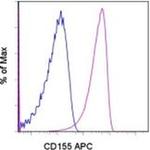Search Thermo Fisher Scientific
FIGURE: 1 / 1
CD155 Antibody (17-1551-82) in Flow

Product Details
17-1551-82
Species Reactivity
Host/Isotype
Recommended Isotype Control
Class
Type
Clone
Conjugate
Excitation/Emission Max
Form
Concentration
Purification
Storage buffer
Contains
Storage conditions
Shipping conditions
RRID
Product Specific Information
Description: This TX56 monoclonal antibody reacts with mouse CD155 (also known as poliovirus receptor or PVR), a member of the Ig superfamily of nectins and nectin-like proteins. CD155 is expressed on thymocytes (e.g. CD4+CD8+ and CD4+ cells), peripheral T and B lymphocytes (e.g. regulatory T cells, activated T cells, marginal zone B cells, and plasma cells), natural killer (NK) cells, dendritic cells (e.g. mature and activated), and monocytes. CD155 interacts with other nectins, including Nectin-3 and the extraceullar matrix protein vitronectin, the adhesion molecule CD226/DNAM-1, and the NK cell receptor CD96. CD155 plays a role in cell-cell adhesion, including formation of adherens junctions, cell migration, polarization, and NK-mediated cytotoxicity. In humans, but not in mice, CD155 is the receptor for poliovirus.
Applications Reported: This TX56 antibody has been reported for use in flow cytometric analysis.
Applications Tested: This TX56 antibody has been tested by flow cytometric analysis on mouse thymocytes. This can be used at less than or equal to 1 µg per test. A test is defined as the amount (µg) of antibody that will stain a cell sample in a final volume of 100 µL. Cell number should be determined empirically but can range from 10^5 to 10^8 cells/test. It is recommended that the antibody be carefully titrated for optimal performance in the assay of interest.
Excitation: 633-647 nm; Emission: 660 nm; Laser: Red Laser.
Filtration: 0.2 µm post-manufacturing filtered.
Target Information
The protein encoded by this gene is a transmembrane glycoprotein belonging to the immunoglobulin superfamily. The external domain mediates cell attachment to the extracellular matrix molecule vitronectin, while its intracellular domain interacts with the dynein light chain Tctex-1/DYNLT1. The gene is specific to the primate lineage, and serves as a cellular receptor for poliovirus in the first step of poliovirus replication. Multiple transcript variants encoding different isoforms have been found for this gene.
For Research Use Only. Not for use in diagnostic procedures. Not for resale without express authorization.
How to use the Panel Builder
Watch the video to learn how to use the Invitrogen Flow Cytometry Panel Builder to build your next flow cytometry panel in 5 easy steps.
References (0)
Bioinformatics
Protein Aliases: FLJ25946; nectin-like 5; poliovirus receptor; sCD112; soluble CD112; tumor-associated antigen 1
Gene Aliases: 3830421F03Rik; CD155; D7Ertd458e; HVED; mE4; necl-5; PVS; Taa1; Tage4
Entrez Gene ID: (Mouse) 52118

Performance Guarantee
If an Invitrogen™ antibody doesn't perform as described on our website or datasheet,we'll replace the product at no cost to you, or provide you with a credit for a future purchase.*
Learn more
We're here to help
Get expert recommendations for common problems or connect directly with an on staff expert for technical assistance related to applications, equipment and general product use.
Contact tech support

